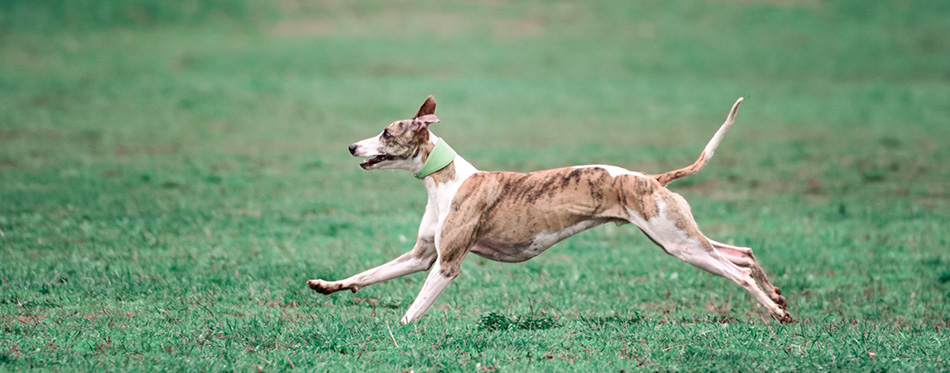Every dog owner has raced (or at least attempted to race) their dog at some point. And, if you are not the running type, you may have watched your dog dash off across the yard a couple of times. You may also have watched it run wild in a park. Whether or not you were impressed by what you saw depends on how fast your dog ran. So, have you watched your dog and wondered how fast can a dog run? If you are reading this article, then the chances are that you have asked yourself that question. So we will now attempt to answer the question, how fast do dogs run, and for how long?

How Fast Can a Dog Run?
So, how fast can a dog run? First of all, it is important to note that, just like humans, dogs do not have a specific speed in general. How fast your dog will be able to run depends on its breed, as well as its weight and health. Thus, dogs do not run at the same speed. Secondly, all dogs do not run in the same manner. Factors such as the length of their legs and physique will play a huge role in determining the speed of their running. Some dogs can run really fast; other dogs cannot run quite as fast. Yet some other dogs are structured to cover very long distances and, therefore, can be classified as endurance dogs. Thus, to answer this question conclusively, we have to cover three different groups of dogs as far as running is concerned – fast dogs, slow dogs, and endurance dogs. But before we proceed, it is best to take a look at how dogs run.
How Do Dogs Run?
As indicated earlier, how fast a dog will be able to run depends on its physical makeup. However, generally, every dog shares a similar appearance and structure to make the very good runners. First of all, every dog has our legs. These four legs come with four feet with nails on each foot that enable them to have a good grip on the running surface. The nails also offer the dogs traction advantages, which allows them to turn swiftly even at top speed. Secondly, dogs run with a dual-suspension advantage. This helps them to combine distance and top speed with relative ease without burning out. Thirdly, dogs have an ideal spine structure for running. The spine runs parallel to the ground as the dog runs. This is complemented by the tight muscles of the abdomen and long loins that accompany them.
All dogs run in the same fashion. They make use of what is normally referred to as a four-time (or four-level) asymmetrical gait. This allows dogs to run with the following pattern – right front leg, left front leg, right hind leg, left hind leg. Before the dog lifts its hind legs from the ground, the front legs would have gone first. However, some dog breeds have the natural ability to lift both sets of legs off the ground at the same time and launch themselves forward.
The Fast Dogs
Dogs, in general, have an average speed of fifteen to twenty miles per hour. However, as mentioned earlier, this may be more or less depending on the dog’s health, physical attributes, and breed. Some breeds of dogs are simply fast runners. A typical example is the Greyhound. The Greyhound dog has the ability to clock up an impressive forty-five miles per hour. This can easily be compared to the speed of the famous powerhouse – the cheetah. Over a long distance, the Greyhound easily matches up to the cheetah. However, over a short distance, the cheetah is a complete bully. The Greyhound is not alone in this group of speedsters. Other contenders include Deerhounds and Salukis. Closely behind them are the Border Collies and German Shepherds. This group can easily clock up to thirty miles per hour. You cannot write off some smaller dog breeds, though. Their short legs are made up for by excellent technique. A Jack Russel Terrier, for example, is capable of speed up to thirty miles per hour.
The Slow Dogs
Life is not fair, is it? Not all dog breeds can be as fast as the Greyhound – not all dog breeds should be. The fast dogs are dominantly made of the long-legged dogs. The little dogs cannot run as fast as eighteen miles per hour. This is obviously due to their smaller legs. A typical example is the Chihuahua. Aside from their small legs, some dogs are hindered by the shape of their noses. You read that right. Some dog breeds have short noses. This is a huge impediment, as it means that they cannot inhale the amount of oxygen to run fast. Even aside from the short nose, size is another impediment. Extra-large breeds of dogs, for example, cannot run fast because of the weight that they carry. An excellent example is the Newfoundland. Other dogs that fall under the slow dogs group are the Bulldog, the toy Poodle, the Shih Tzu, the French Bulldog, the Pug, and the Basset Hound. None of the dogs mentioned above can run more than fifteen miles per hour. The Toy Poodle and the Pug are the slowest. Both have a top speed of just ten miles per hour.
The Endurance Dogs
This group of dogs may not necessarily have impressive top speed numbers. However, they have the ability to maintain the same speed over very long distances without slowing down. This group of dogs includes the Siberian Husky, the Dalmatian, the Standard Poodle, the Labrador Retriever. They have a general top speed of ten to fifteen miles per hour. With respect to the endurance dogs, most people have asked, how many miles can a dog run? Most of these dogs can eat up a mile in an average of six minutes.

To Summarize
So, how fast can a dog run? The answer is determined by so many factors – size, health, structure, name them. Whichever group your dog happens to fall in, the most important thing is to ensure that it runs enough to give it the exercise and min-stimulation it needs to remain healthy.

